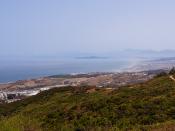Historical Summary
The history of Mexico began when Indians of unknown tribes migrated from the north into what is now Mexico. They arrived before 8000 B.C. These people were hunters who followed herds of buffalo, mammoths, mastodons, and other large animals. Their way of life explains why they lived in small, temporary communities. Then in 7500 B.C., the climate became drier, and the herds could not find enough food and became extinct. Because of this change the Indians began to survive off of small animals, berries, and seeds of wild plants. Around 7000 B.C. Indians learned how to grow plants and became farmers. They grew many things such as corn, avocados, beans, peppers, squashes, and tomatoes. In addition, they raised dogs and turkeys for food. As time passed, the Indians became more advanced and the Olmec Indians developed a counting system and calendar. The reason for the fall of the classic civilizations is still not known.
The most memorable Indian empire was that of he Aztecs. Since the Aztecs were warriors, they believed it was their duty to sacrifice their prisoners to their gods. The people that they conquered resented them for this belief cause every year they would kill thousands of men who had been captured. Unlike their warlike ways, the Aztecs composed music and poetry, and were skillful in the subject of medicine. They were also an extremely rich civilization from the gold, silver, and other treasures that were paid to them by the cities and tribes they had conquered.
Mexico was discovered by the Spanish in 1517. Diego Velazquez, the governor of Cuba, sent ships under the command of Francisco Fernandez de Cordoba to explore the west and search for treasure. He landed on the Yucatan Peninsula and brought back reports of large cities. Reports of the...


